|
HARQ in a Nutshell
- HARQ stands for Hybrid ARQ(Automatic Repeat reQuest)
- Hybrid implies the combination of Error Correction(FEC) and ARQ
- FEC involves adding redundant bits to the original data to allow error detection and correction at the receiver, while ARQ is a feedback mechanism where the receiver sends a retransmission request if an error is detected in the received data.
- It is a special physical layer message that indicates the success or failure of PDSCH decoding in UE (In NR, PUSCH does not required Ack/Nack. This is a difference between NR and LTE)
- The time gap between PDSCH and corresponding Ack/Nack (k1) is not fixed any more (this is another difference between NR and LTE).
- The time gap between PDSCH and corresponding Ack/Nack (k1) is determined by the combination of RRC Configuration and DCI.
- Number of HARQ processor is configured in RRC and the max number of the process is 16.
|
HARQ in Detail
What is H-ARQ ? Why it uses the term "Hybrid" ?
First think about the term ARQ. ARQ stands for Automatic Repeat Request and you would have heard this a lot if you had experience of studying IP communication (I think you can google a lot of tutorials on this, so I would not explain about what is ARQ here). The "H" in HARQ means "Hybrid" which implies that HARQ is a combination of "Something" and "ARQ".
Then what would be the "Something" ? The "Something" is FEC (forward error correction). FEC is also not LTE specific technology and a kind of generic error correction mechanism. So I would like you to google something about FEC.
The transmission and reception process involves transmitting data, receiving ACK or NACK, and performing retransmissions if necessary. The whole procedure (transmission, reception and ack/nack reporting, retransmission) is done by a speciall process called HARQ process. A few typical examples of HARQ operation are illustrated below.
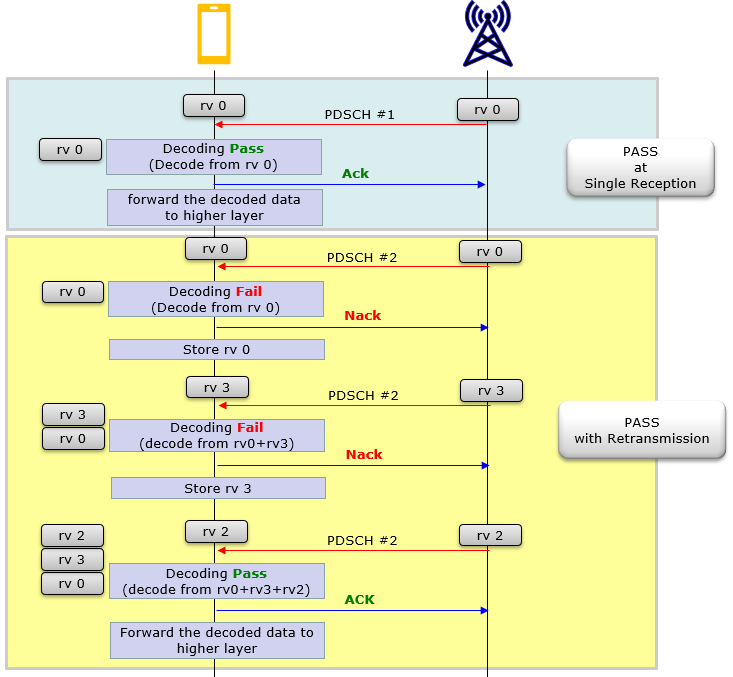
Followings are descriptions for the diagam shown above.
Case 1: Pass at the first reception
- Transmission: The gNB (base station) transmits PDSCH with rv 0 to the UE (User Equipment) over the PDSCH.
- Reception: The UE receives the data and performs error detection using the CRC (Cyclic Redundancy Check).
- ACK/NACK: If the CRC is OK, the UE sends an ACK message to the eNodeB through PUCCH or PUSCH, indicating successful reception.
- Since the transmission was successful, there is no need for retransmissions in this case. There is no need to save the data in HARQ buffer and UE forward the decoded data to higher layer.
Case 2: Pass with Retransmissions
- First Transmission: The gNB (base station) transmits PDSCH with rv 0 to the UE (User Equipment) over the PDSCH.
- First Reception: The UE receives the data and performs error detection using the CRC. The CRC fails, indicating a decoding failure.
- First ACK/NACK: The UE sends a NACK message to the gNB through the PUCCH or PUSCH, indicating a decoding failure.
- First Retransmission: Based on the NACK, the gNB retransmits the data with a different RV (e.g., RV=3) to increase the likelihood of successful decoding.
- Second Reception: The UE receives the retransmitted data and performs error detection using the CRC. The CRC fails again, indicating another decoding failure. When UE decode data, it combines the previous data stored in the buffer and the current data it just recieved, and then decode the combined data.
- Second ACK/NACK: The UE sends another NACK message to the eNodeB, indicating a second decoding failure.
- Second Retransmission: Based on the second NACK, the gNB retransmits the data again with a different RV (e.g., RV=2) to further increase the likelihood of successful decoding.
- Third Reception: The UE receives the retransmitted data and performs error detection using the CRC. The CRC is OK this time, indicating successful decoding. When UE decode data, it combines all the previous data stored in the buffer and the current data it just recieved, and then decode the combined data.
- Third ACK/NACK: The UE sends an ACK message to the gNB, indicating successful reception after the third transmission attempt.
NOTE : You see a new concept called rv (redundancy version). You will get to know of this in later section.
Basic concept of HARQ in NR is similar to LTE HARQ, but there is some mintor differences in terms of the details. In this page, I will try to explain NR HARQ in comparison to LTE HARQ. So if you are already familiar with LTE HARQ, it will be a great help to understand NR HARQ.
Asynchronous HARQ in both downlink and Uplink : In LTE HARQ, downlink use Asynchronous mechanism but Uplink uses Synchronous mechanism. In contrast, in NR both downlink and Uplink Asynchronous mechanism is used. (For the definition of Ascynchronous HARQ and Synchronous
HARQ, refer to LTE HARQ). Just to give you an practical aspect of Asynchronous HARQ, it operates the multiple HARQ processes in any order. To keep track of each HARQ process even when they are not running in order, the sender and reciever in the HARQ process should know the exact HARQ process number for each transmission/reception of the HARQ data. For this, DCI carries the field called HARQ Processor number. In LTE, only the DCI for downlink scheduling
(i.e, DCI 1, DCI 2 etc) carries this field (since LTE DL use Asynchronous HARQ) and the DCI for uplink schedule(i.e, DCI 0) does not carry this field(since LTE UL use Synchronous HARQ). However in NR, both Downlink Scheduling DCI (i.e, DCI 1_0, 1_1) and Uplink Scheduling
DCI (i.e, DCI 0_0,
0_1) carries the field HARQ Processor Number since they both use Asychronous HARQ.
Flexible Timing between Data Transmission and HARQ response : In LTE the timing between data transmission and HARQ response is fixed. It is fixed as 4 ms in FDD. The timing is determined in a little bit complicated way in LTE TDD. But this timing is flexibly set in NR in combination of DCI and RRC.
In
NR, RRC message defined a table listing multiple possible timing between data and HARQ and DCI specifies a specific elements of the table defined in the RRC message. Refer to Resource Allocation page for the details of RRC and DCI interaction for this timing.
Codebook Based HARQ Bit Construction : The number of bits and the meaning of each bits in HARQ response is quite a straightforward, but in NR the number of the HARQ bits is constructed in pretty complicated way as described in HARQ-ACK Codebook page.
NO ACK/NACK for PUSCH : At the very high level view, NR PUSCH HARQ mechanism is very similar to NB IoT PUSCH mechanism. There is no explicit HARQ ACK/NACK for PUSCH. Then, how UE can figure out whther the PUSCH is successfully delivered
or not ? It figures
it out based on whether it gets retransmission request from gNB or not. If gNB does not send retransmission request (i.e, DCI 0_0/0_1 with NDI not toggled) for a certain period of time, UE assumes that PUSCH is successfully recieved and decoded by gNB.
Even though both TDD and FDD are allowed in NR, it is likely that TDD will be used in most case of NR operation. So it would be beneficial if you have good understandings on how HARQ ACK/NACK timing is determined in TDD LTE (See here if you are not familiar with TDD LTE HARQ Timing). As you know, TDD LTE HARQ
ACK/NACK timing
is
specified by a predefined table. But in TDD NR, HARQ ACK/NACK timing is fully configurable. You can configure HARQ ACK/NACK timing for a specific PDSCH by specifying the parameter K1.
As an example, let's supposed your slot configuration is DDDDU with 2.5 ms period. You can configure in such a way that HARQ ACK/NACK for all the PDSCH is transmitted at the same UL slot by specifying K1 as follows. (If you are not familiar with what is K1 and how these values can be configured and informed to UE, see here).
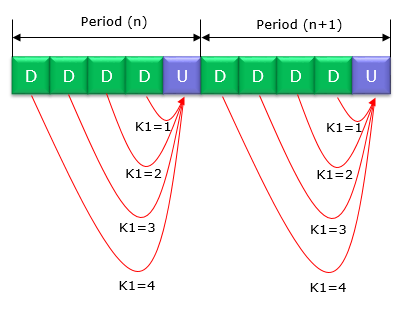
If necessary, you can configure HARQ ACK/NACK timing as flexible as shown below.
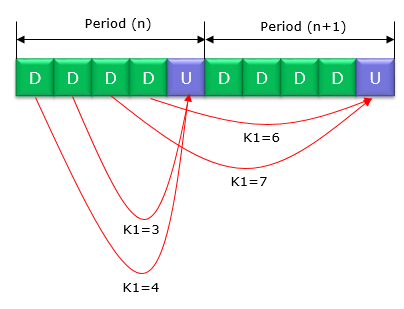
You may ask 'How far HARQ ACK/NACK can be away from the transmitted PDSCH ? It is up to the maximum K1 value settable in RRC message. As of 2018 Sep specification, the maximum K1 value is 15 as you see here
)
When a transmission (or retransmission) takes place, the original data bits are encoded using a specific Forward Error Correction (FEC) scheme(e.g, LDPC). The encoded bits are then punctured or rate-matched to create a set of output bits for transmission. The redundancy version determines which bits are selected for transmission, and different RVs will result in different sets of bits
being sent.
The selection of bits in different redundancy versions is usually achieved using a circular buffer and a specific interleaving pattern for each RV. As a result, each RV will provide a different portion of the rate-matched output, increasing the chances of successful decoding at the receiver
Each of the rv (redundancy version) is constructed from the bits in a circular buffer that are stored during the rate match process. Each of the rv bits is illustrated as below.
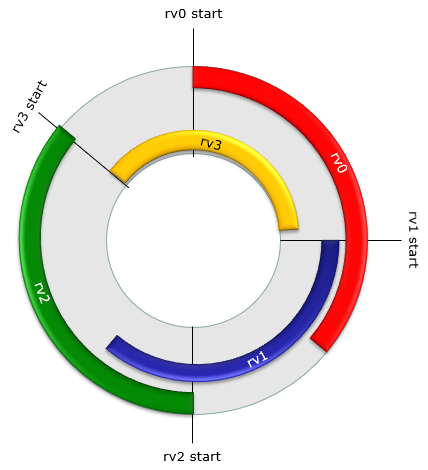
Start of each rv is specified by 3GPP as below :
< 38.212-Table 5.4.2.1-2: Starting position of different redundancy versions >
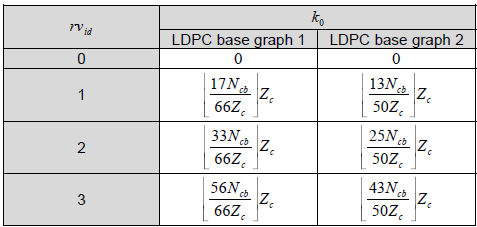

Which rv version is transmitted at each transmission is specified in DCI as shown in the example below.
Theoretically network can transmit any rv for each transmission, but usually rv sequence is 0->2->3->1. It indicates :
- at 1st transmittion : rv0 is transmitted
- at 2nd transmittion : rv2 is transmitted
- at 3rd transmittion : rv3 is transmitted
- at 4th transmittion : rv1 is transmitted
Unlike LTE, in NR the max number of HARQ processor is configurable in RRC message as shown below. If this IE is not configured, it is assumed to be 8.
PDSCH-ServingCellConfig ::= SEQUENCE {
codeBlockGroupTransmission SetupRelease { PDSCH-CodeBlockGroupTransmission } OPTIONAL,
xOverhead ENUMERATED { xOh6, xOh12,
xOh18 } OPTIONAL,
nrofHARQ-ProcessesForPDSCH ENUMERATED {n2, n4, n6, n10, n12, n16} OPTIONAL,
pucch-Cell ServCellIndex OPTIONAL,
-- Cond SCellAddOnly
[[
maxMIMO-Layers INTEGER (1..8) OPTIONAL, -- Need M
processingType2Enabled BOOLEAN OPTIONAL -- Need M
]]
}
Following is a sample trace log showing sequences of HARQ from Amarisoft.
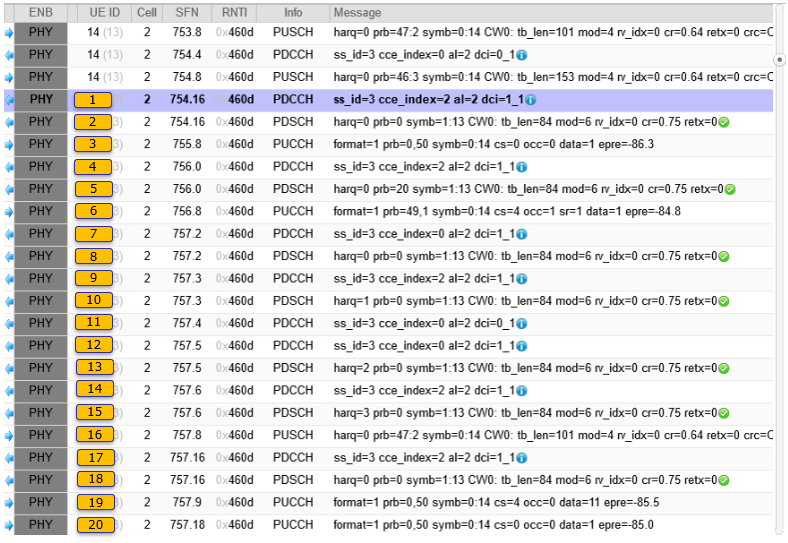
|
RRC Parameters
: In LTE, UE and gNB was able to decode PDSCH and PUSCH purely based on DCI, but in NR to receive PDSCH and PUSCH at proper timing and to get some critical parameters from RRC message that are required for PDSCH/PUSCH decoding. Followings are those parameters in RRC.
|
|
tdd-UL-DL-ConfigurationCommon {
referenceSubcarrierSpacing kHz30,
pattern1 {
dl-UL-TransmissionPeriodicity ms5,
nrofDownlinkSlots 7,
nrofDownlinkSymbols 2,
nrofUplinkSlots 2,
nrofUplinkSymbols 0
}
},
pdsch-ConfigCommon setup: {
pdsch-TimeDomainAllocationList {
{
mappingType typeA,
startSymbolAndLength 40
}
}
}
pusch-ConfigCommon setup: {
pusch-TimeDomainAllocationList {
{
k2 4,
mappingType typeA,
startSymbolAndLength 27
},
{
k2 4,
mappingType typeA,
startSymbolAndLength 27
}
},
dl-DataToUL-ACK {
8,
6,
4,
12
}
pucch-Config setup: {
resourceSetToAddModList {
{
pucch-ResourceSetId 0,
resourceList {
0,
1,
2,
3,
4,
5,
6,
7
}
},
{
pucch-ResourceSetId 1,
resourceList {
8,
9,
10,
11,
12,
13,
14,
15
}
}
},
resourceToAddModList {
{
pucch-ResourceId 0,
startingPRB 0,
intraSlotFrequencyHopping enabled,
secondHopPRB 50,
format format1: {
initialCyclicShift 0,
nrofSymbols 14,
startingSymbolIndex 0,
timeDomainOCC 0
}
},
{
pucch-ResourceId 1,
startingPRB 0,
intraSlotFrequencyHopping enabled,
secondHopPRB 50,
format format1: {
initialCyclicShift 4,
nrofSymbols 14,
startingSymbolIndex 0,
timeDomainOCC 0
}
},
{
pucch-ResourceId 2,
startingPRB 0,
intraSlotFrequencyHopping enabled,
secondHopPRB 50,
format format1: {
initialCyclicShift 8,
nrofSymbols 14,
startingSymbolIndex 0,
timeDomainOCC 0
}
},
{
pucch-ResourceId 3,
startingPRB 0,
intraSlotFrequencyHopping enabled,
secondHopPRB 50,
format format1: {
initialCyclicShift 0,
nrofSymbols 14,
startingSymbolIndex 0,
timeDomainOCC 1
}
},
{
pucch-ResourceId 4,
startingPRB 0,
intraSlotFrequencyHopping enabled,
secondHopPRB 50,
format format1: {
initialCyclicShift 4,
nrofSymbols 14,
startingSymbolIndex 0,
timeDomainOCC 1
}
},
{
pucch-ResourceId 5,
startingPRB 0,
intraSlotFrequencyHopping enabled,
secondHopPRB 50,
format format1: {
initialCyclicShift 8,
nrofSymbols 14,
startingSymbolIndex 0,
timeDomainOCC 1
}
},
{
pucch-ResourceId 6,
startingPRB 0,
intraSlotFrequencyHopping enabled,
secondHopPRB 50,
format format1: {
initialCyclicShift 0,
nrofSymbols 14,
startingSymbolIndex 0,
timeDomainOCC 2
}
},
{
pucch-ResourceId 7,
startingPRB 0,
intraSlotFrequencyHopping enabled,
secondHopPRB 50,
format format1: {
initialCyclicShift 4,
nrofSymbols 14,
startingSymbolIndex 0,
timeDomainOCC 2
}
},
{
pucch-ResourceId 8,
startingPRB 50,
intraSlotFrequencyHopping enabled,
secondHopPRB 0,
format format4: {
nrofSymbols 14,
occ-Length n4,
occ-Index n0,
startingSymbolIndex 0
}
},
{
pucch-ResourceId 9,
startingPRB 50,
intraSlotFrequencyHopping enabled,
secondHopPRB 0,
format format4: {
nrofSymbols 14,
occ-Length n4,
occ-Index n1,
startingSymbolIndex 0
}
},
{
pucch-ResourceId 10,
startingPRB 50,
intraSlotFrequencyHopping enabled,
secondHopPRB 0,
format format4: {
nrofSymbols 14,
occ-Length n4,
occ-Index n2,
startingSymbolIndex 0
}
},
{
pucch-ResourceId 11,
startingPRB 50,
intraSlotFrequencyHopping enabled,
secondHopPRB 0,
format format4: {
nrofSymbols 14,
occ-Length n4,
occ-Index n3,
startingSymbolIndex 0
}
},
{
pucch-ResourceId 12,
startingPRB 1,
intraSlotFrequencyHopping enabled,
secondHopPRB 49,
format format4: {
nrofSymbols 14,
occ-Length n4,
occ-Index n0,
startingSymbolIndex 0
}
},
{
pucch-ResourceId 13,
startingPRB 1,
intraSlotFrequencyHopping enabled,
secondHopPRB 49,
format format4: {
nrofSymbols 14,
occ-Length n4,
occ-Index n1,
startingSymbolIndex 0
}
},
{
pucch-ResourceId 14,
startingPRB 1,
intraSlotFrequencyHopping enabled,
secondHopPRB 49,
format format4: {
nrofSymbols 14,
occ-Length n4,
occ-Index n2,
startingSymbolIndex 0
}
},
{
pucch-ResourceId 15,
startingPRB 1,
intraSlotFrequencyHopping enabled,
secondHopPRB 49,
format format4: {
nrofSymbols 14,
occ-Length n4,
occ-Index n3,
startingSymbolIndex 0
}
},
{
pucch-ResourceId 16,
startingPRB 49,
intraSlotFrequencyHopping enabled,
secondHopPRB 1,
format format1: {
initialCyclicShift 4,
nrofSymbols 14,
startingSymbolIndex 0,
timeDomainOCC 1
}
}
},
format1 setup: {
},
format4 setup: {
maxCodeRate zeroDot25
},
schedulingRequestResourceToAddModList {
{
schedulingRequestResourceId 1,
schedulingRequestID 0,
periodicityAndOffset sl40: 8,
resource 16
}
pdcch-ConfigCommon setup: {
commonControlResourceSet {
controlResourceSetId 1,
frequencyDomainResources '111100000000000000000000000000000000000000000'B,
duration 1,
cce-REG-MappingType nonInterleaved: NULL,
precoderGranularity sameAsREG-bundle
},
commonSearchSpaceList {
{
searchSpaceId 1,
controlResourceSetId 1,
monitoringSlotPeriodicityAndOffset sl1: NULL,
monitoringSymbolsWithinSlot '10000000000000'B,
nrofCandidates {
aggregationLevel1 n0,
aggregationLevel2 n0,
aggregationLevel4 n1,
aggregationLevel8 n0,
aggregationLevel16 n0
},
searchSpaceType common: {
dci-Format0-0-AndFormat1-0 {
}
}
}
},
},
pdcch-Config setup: {
searchSpacesToAddModList {
{
searchSpaceId 2,
controlResourceSetId 1,
monitoringSlotPeriodicityAndOffset sl1: NULL,
monitoringSymbolsWithinSlot '10000000000000'B,
nrofCandidates {
aggregationLevel1 n1,
aggregationLevel2 n1,
aggregationLevel4 n1,
aggregationLevel8 n0,
aggregationLevel16 n0
},
searchSpaceType ue-Specific: {
dci-Formats formats0-0-And-1-0
}
},
{
searchSpaceId 3,
controlResourceSetId 1,
monitoringSlotPeriodicityAndOffset sl1: NULL,
monitoringSymbolsWithinSlot '10000000000000'B,
nrofCandidates {
aggregationLevel1 n1,
aggregationLevel2 n1,
aggregationLevel4 n1,
aggregationLevel8 n0,
aggregationLevel16 n0
},
searchSpaceType ue-Specific: {
dci-Formats formats0-1-And-1-1
}
}
}
},
|
To analyze HARQ process, the first thing you need to do is to identify a specific HARQ number and follow through all the steps with the same HARQ process number. In this example, I marked HARQ process number with different color.
| [1] PDCCH - SFN : 754.16 |
From: test.log
Info: 192.168.1.41:9001, v2019-05-13
Time: 16:15:50.136
Message: ss_id=3 cce_index=2 al=2 dci=1_1
Data:
rb_alloc=0x0
mcs1=24
ndi1=1
rv_idx1=0
harq_process=0
dai=0
tpc_command=1
pucch_rsc=0 // According to RRC, this indicate PUCCH format 1 with the config shown here.
harq_feedback_timing=3 // According to dl-DataToUL-ACK, this indicate K1 = 12
antenna_ports=0
srs_request=0
dmrs_seq_init=0
|
|
[2] PDSCH - SFN : 754.16
|
|
From: test.log
Info: 192.168.1.41:9001, v2019-05-13
Time: 16:15:50.136
Message: harq=0 prb=0 symb=1:13 CW0: tb_len=84 mod=6 rv_idx=0 cr=0.75 retx=0
|
|
[3] PUCCH - SFN : 755.8
|
|
From: test.log
Info: 192.168.1.41:9001, v2019-05-13
Time: 16:15:50.146
Message: format=1 prb=0,50 symb=0:14 cs=0 occ=0 data=1 epre=-86.3
|
|
[4] PDCCH - SFN : 756.0
|
|
From: test.log
Info: 192.168.1.41:9001, v2019-05-13
Time: 16:15:50.148
Message: ss_id=3 cce_index=2 al=2 dci=1_1
Data:
rb_alloc=0x14
mcs1=24
ndi1=0
rv_idx1=0
harq_process=0
dai=0
tpc_command=1
pucch_rsc=0 // According to RRC, this indicate PUCCH format 1 with the config shown here
harq_feedback_timing=0 // According to dl-DataToUL-ACK, this indicate K1 = 8
antenna_ports=0
srs_request=0
dmrs_seq_init=0
|
|
[5] PDSCH - SFN : 756.0
|
|
From: test.log
Info: 192.168.1.41:9001, v2019-05-13
Time: 16:15:50.148
Message: harq=0 prb=20 symb=1:13 CW0: tb_len=84 mod=6 rv_idx=0 cr=0.75 retx=0
|
|
[6] PUCCH - SFN : 756.8
|
|
From: test.log
Info: 192.168.1.41:9001, v2019-05-13
Time: 16:15:50.156
Message: format=1 prb=49,1 symb=0:14 cs=4 occ=1 sr=1 data=1 epre=-84.8
|
|
[7] PDCCH - SFN : 757.2
|
|
From: test.log
Info: 192.168.1.41:9001, v2019-05-13
Time: 16:15:50.159
Message: ss_id=3 cce_index=0 al=2 dci=1_1
Data:
rb_alloc=0x0
mcs1=24
ndi1=1
rv_idx1=0
harq_process=0
dai=0
tpc_command=1
pucch_rsc=0 // According to RRC, this indicate PUCCH format 1 with the config shown here
harq_feedback_timing=1 // According to dl-DataToUL-ACK, this indicate K1 = 6
antenna_ports=0
srs_request=0
dmrs_seq_init=0
|
|
[8] PDSCH - SFN : 757.2
|
|
From: test.log
Info: 192.168.1.41:9001, v2019-05-13
Time: 16:15:50.159
Message: harq=0 prb=0 symb=1:13 CW0: tb_len=84 mod=6 rv_idx=0 cr=0.75 retx=0
|
|
[9] PDCCH - SFN : 757.3
|
|
From: test.log
Info: 192.168.1.41:9001, v2019-05-13
Time: 16:15:50.160
Message: ss_id=3 cce_index=2 al=2 dci=1_1
Data:
rb_alloc=0x0
mcs1=24
ndi1=1
rv_idx1=0
harq_process=1
dai=0
tpc_command=1
pucch_rsc=0 // According to RRC, this indicate PUCCH format 1 with the config shown here
harq_feedback_timing=1 // According to dl-DataToUL-ACK, this indicate K1 = 6
antenna_ports=0
srs_request=0
dmrs_seq_init=0
|
|
[10] PDSCH - SFN : 757.3
|
|
From: test.log
Info: 192.168.1.41:9001, v2019-05-13
Time: 16:15:50.160
Message: harq=1 prb=0 symb=1:13 CW0: tb_len=84 mod=6 rv_idx=0 cr=0.75 retx=0
|
|
[11] PDCCH - SFN : 757.4
|
|
From: test.log
Info: 192.168.1.41:9001, v2019-05-13
Time: 16:15:50.160
Message: ss_id=3 cce_index=0 al=2 dci=0_1
Data:
rb_alloc=0x62
time_domain_rsc=0
mcs=16
ndi=1
rv_idx=0
harq_process=0
dai=0
tpc_command=1
antenna_ports=0
srs_request=0
dmrs_seq_init=0
ul_sch_indicator=1
|
|
[12] PDCCH - SFN : 757.5
|
|
From: test.log
Info: 192.168.1.41:9001, v2019-05-13
Time: 16:15:50.161
Message: ss_id=3 cce_index=0 al=2 dci=1_1
Data:
rb_alloc=0x0
mcs1=24
ndi1=1
rv_idx1=0
harq_process=2
dai=1
tpc_command=1
pucch_rsc=1 // According to RRC, this indicate PUCCH format 1 with the config shown here
harq_feedback_timing=2 // According to dl-DataToUL-ACK, this indicate K1 = 4
antenna_ports=0
srs_request=0
dmrs_seq_init=0
|
|
[13] PDSCH - SFN : 757.5
|
|
From: test.log
Info: 192.168.1.41:9001, v2019-05-13
Time: 16:15:50.161
Message: harq=2 prb=0 symb=1:13 CW0: tb_len=84 mod=6 rv_idx=0 cr=0.75 retx=0
|
|
[14] PDCCH - SFN : 757.6
|
|
From: test.log
Info: 192.168.1.41:9001, v2019-05-13
Time: 16:15:50.161
Message: ss_id=3 cce_index=2 al=2 dci=1_1
Data:
rb_alloc=0x0
mcs1=24
ndi1=1
rv_idx1=0
harq_process=3
dai=0
tpc_command=1
pucch_rsc=0 // According to RRC, this indicate PUCCH format 1 with the config shown here
harq_feedback_timing=3 // According to dl-DataToUL-ACK, this indicate K1 = 12
antenna_ports=0
srs_request=0
dmrs_seq_init=0
|
|
[15] PDSCH - SFN : 757.6
|
|
From: test.log
Info: 192.168.1.41:9001, v2019-05-13
Time: 16:15:50.161
Message: harq=3 prb=0 symb=1:13 CW0: tb_len=84 mod=6 rv_idx=0 cr=0.75 retx=0
|
|
[16] PUSCH - SFN : 757.8
|
|
From: test.log
Info: 192.168.1.41:9001, v2019-05-13
Time: 16:15:50.166
Message: harq=0 prb=47:2 symb=0:14 CW0: tb_len=101 mod=4 rv_idx=0 cr=0.64 retx=0 crc=OK snr=28.8 epre=-83.3 ack=1
|
|
[17] PDSCH - SFN : 757.16
|
|
From: test.log
Info: 192.168.1.41:9001, v2019-05-13
Time: 16:15:50.166
Message: ss_id=3 cce_index=2 al=2 dci=1_1
Data:
rb_alloc=0x0
mcs1=24
ndi1=0
rv_idx1=0
harq_process=0
dai=0
tpc_command=1
pucch_rsc=0 // According to RRC, this indicate PUCCH format 1 with the config shown here
harq_feedback_timing=3 // According to dl-DataToUL-ACK, this indicate K1 = 12
antenna_ports=0
srs_request=0
dmrs_seq_init=0
|
|
[18] PDSCH - SFN : 757.16
|
|
From: test.log
Info: 192.168.1.41:9001, v2019-05-13
Time: 16:15:50.166
Message: harq=0 prb=0 symb=1:13 CW0: tb_len=84 mod=6 rv_idx=0 cr=0.75 retx=0
|
|
[19] PUCCH - SFN : 757.9
|
|
From: test.log
Info: 192.168.1.41:9001, v2019-05-13
Time: 16:15:50.167
Message: format=1 prb=0,50 symb=0:14 cs=4 occ=0 data=11 epre=-85.5
|
|
[20] PUCCH - SFN : 757.18
|
|
From: test.log
Info: 192.168.1.41:9001, v2019-05-13
Time: 16:15:50.171
Message: format=1 prb=0,50 symb=0:14 cs=0 occ=0 data=1 epre=-85.0
|
Reference
|
|






